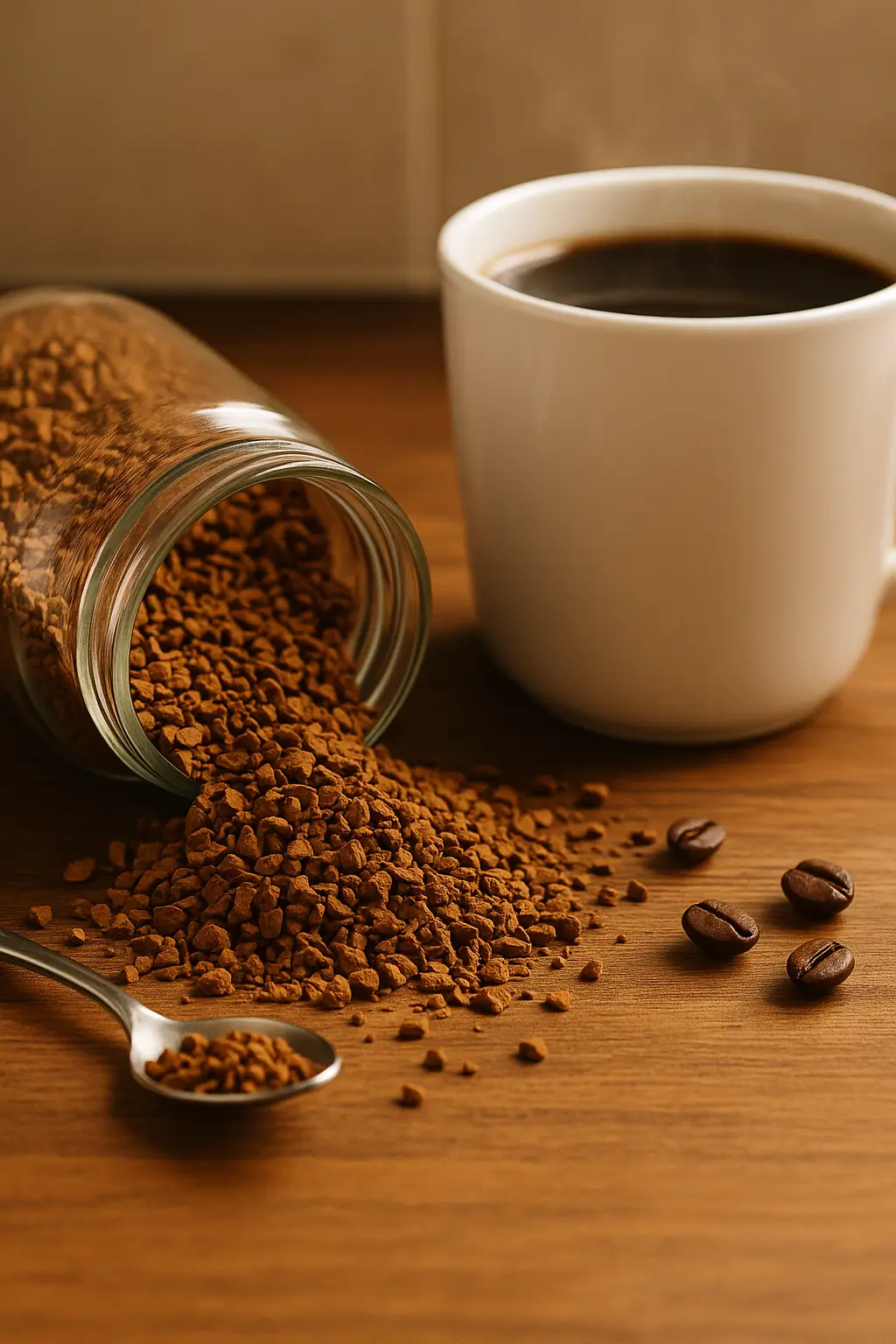Think about instant coffee granules. They’re a pretty cool invention, right? What used to be a whole brewing ritual now takes just a second. These tiny, dried bits of roasted coffee offer so much convenience to millions of us every day. Have you ever stopped to wonder how these little crystals end up in your mug, where they come from, or why they dissolve so easily? Let’s take a look at the journey of instant coffee, from its creation and different types to its unique place in the coffee world.
- What exactly are instant coffee granules?
- The journey from bean to granule: how instant coffee is made
- Types of instant coffee: spray-dried vs. freeze-dried
- Instant coffee granules: pros & cons compared to traditional coffee
- What’s actually in instant coffee granules?
- Keeping it fresh: instant coffee shelf life & storage
- Wrapping up
What exactly are instant coffee granules?
Instant coffee granules are basically the concentrated form of brewed coffee, just without the water. Manufacturers start with roasted, ground coffee beans – often using Robusta beans because they have a strong flavor and cost less. They then dehydrate this brewed coffee into a powder or crystals. These granules quickly dissolve in hot water, giving you a cup of coffee without needing any brewing gear.
The biggest perks of these granules are how incredibly easy they are to use and their long shelf life. They’re a quick coffee fix for anyone busy or traveling. That’s why instant coffee shows up in so many homes.
The journey from bean to granule: how instant coffee is made
Making instant coffee means turning whole beans into those quick-dissolving granules. This involves a few exact steps. The whole point is to get the soluble parts of the coffee out, concentrate them, and then dry them. When you understand this process, you see the science behind every fast cup of instant coffee.
How is coffee extracted during instant coffee production?
The first step in making instant coffee granules is brewing. Manufacturers coarsely grind roasted coffee beans. Then, they use hot water under pressure – usually between 80°C and 175°C – in big, multi-stage systems.
This extracts the soluble parts, like caffeine, natural oils, and other aromatic compounds from the ground coffee. What you get is a concentrated coffee extract, typically 20-35% soluble solids. This step catches the coffee’s basic taste before anything else happens.
Why do they concentrate coffee extract for instant coffee granules?
The next step is concentration. This reduces the water in the brewed coffee extract, getting it ready for drying. They often use vacuum evaporation, which gently takes out water at lower temperatures. This is important because it stops the delicate aroma compounds – the ones that give coffee its flavor – from getting damaged.
The liquid coffee extract turns into a thick, sticky concentrate. Some companies even capture and put back lost aroma compounds, helping the coffee keep its natural smell. This step helps maintain the quality of the instant coffee granules.
What are the main ways they dry instant coffee granules?
Drying is the stage where concentrated liquid coffee becomes solid instant coffee granules. This takes out almost all the water, leaving just the soluble coffee solids. Two main methods do this: spray drying and freeze drying. Each gives the final product different traits.
How does spray drying make instant coffee granules?
The spray drying technique is a quick and cheaper way to make instant coffee. Manufacturers spray the liquid coffee extract into a chamber with hot air, often around 250 °C. The hot air quickly evaporates the water, leaving fine powder granules.
This method is fast, but the high heat can sometimes lessen the delicate flavor and aroma. So, people often like spray-dried coffee for its speed and low cost, not necessarily its complex taste. It gives you a uniform powder that dissolves almost instantly.
How does freeze drying change instant coffee granules?
Freeze drying costs more, but it helps keep the quality high for instant coffee granules. This method freezes the concentrated coffee extract at very cold temperatures, usually -40°C to -50°C. They then break the frozen extract into small granules.
Next, a process called vacuum sublimation turns the ice directly into vapor. It skips the liquid stage entirely. This gentle approach really helps preserve the coffee’s original aroma and flavor. Freeze-dried instant coffee granules usually look bigger and more irregular. They also give you a better taste.
How do they package instant coffee granules to keep them fresh?
Packaging is the last step for instant coffee granules. After drying and removing moisture, the granules go through strict quality checks. Then, they get packed carefully into airtight containers.
This step stops air and moisture from getting to the instant coffee, which could ruin its quality. Good packaging is important for keeping the product’s freshness and unique flavor until you buy it. Airtight seals make sure the granules stay strong and aromatic.
Types of instant coffee: spray-dried vs. freeze-dried
When you’re choosing instant coffee granules, you’ll generally see two main kinds: spray-dried coffee and freeze-dried coffee. These names tell you about the drying method used, which really affects the quality, taste, and price. Knowing the differences helps you pick what you like best.
What’s spray-dried instant coffee like?
Spray-dried instant coffee looks like fine, even powder particles. They make it through a fast, high-heat process. This method is usually quicker and cheaper to produce, making it a budget-friendly choice. But, those high temperatures can mean less preserved flavor and fewer delicate aroma compounds.
The fine powder dissolves almost instantly in hot water. You’ll find this type of instant coffee in cheaper options and where people care more about speed and saving money than a complex taste. It’s a handy choice for daily use or when you’re out and about.
What makes freeze-dried instant coffee different?
Freeze-dried instant coffee has larger, often oddly shaped granules or crystals. People know it for keeping its flavor and aroma better. This method freezes the coffee extract, then removes water through sublimation, which skips high heat. It costs more and takes longer to make, but it gives you a higher-quality coffee experience.
If you want a taste closer to traditionally brewed coffee, you’ll probably prefer freeze-dried types. The gentle drying helps keep those volatile aroma compounds and the natural taste of the beans intact. This gives you a richer, more complex cup.
Spray-dried vs. freeze-dried instant coffee granules: a quick look
The main differences between spray-dried and freeze-dried instant coffee granules come down to how they’re made and what that does to the final product. Here’s a quick comparison of those differences:
| Aspect | Spray-Dried Instant Coffee | Freeze-Dried Instant Coffee |
|---|---|---|
| Drying Technique | Hot air evaporation of sprayed liquid mist | Sublimation of frozen coffee concentrate |
| Particle Shape | Fine, uniform powder | Larger, irregular granules with internal structure |
| Flavor Preservation | Less, due to high heat | Better, retains more aroma and flavor nuances |
| Solubility | Quick, powder dissolves rapidly | Dissolves well, but granules may take a bit longer |
| Cost and Complexity | Cheaper and faster process | More expensive and complex process |
| Typical Uses | Quick, convenient use, cooking | Preferred for higher-quality coffee experience |
Instant coffee granules: pros & cons compared to traditional coffee
When you stack instant coffee granules against traditional methods, like using ground coffee or whole bean coffee, you see some clear upsides and downsides. Many people ask, “What’s the difference between instant coffee vs ground coffee?” This comparison shows how each choice fits different needs.
What are the good things about instant coffee granules?
Instant coffee granules have some really good points, making them a popular choice. These benefits mostly focus on how easy and efficient they are in your daily life. Here are some of the advantages:
- Convenience: You don’t need any special equipment for instant coffee; just add hot water.
- Speed: It takes only seconds to make, perfect for busy mornings or fast breaks.
- Cost-effectiveness: Instant coffee is usually cheaper per serving than making traditional coffee.
- Portability: It’s light and compact, great for travel, camping, or the office.
- Longer shelf life: Instant coffee stays good for a much longer time than fresh grounds.
These points show why instant coffee granules are a practical pick for anyone wanting a quick, simple coffee fix.
What are the downsides of instant coffee granules?
Sure, instant coffee is easy, but it does have some drawbacks when you compare it to traditionally brewed coffee. These usually involve how it tastes and smells, and what’s in it. Here are the main disadvantages:
- Less complex flavor: Instant coffee often tastes more bitter or earthy and has less complex aroma. This comes from how it’s processed and because manufacturers often use Robusta beans.
- Less caffeine: A typical cup of instant coffee has about 60–80mg of caffeine. Ground coffee, however, usually has 80–140mg or even more.
- Not as fresh: The flavor isn’t usually as vibrant or nuanced. It often misses the rich aroma of freshly brewed coffee.
These things mean instant coffee gives you a less premium experience, especially if you’re used to traditional brewing. Coffee lovers often look for those specific flavors and aromatic compounds that instant coffee might not have.
Instant coffee vs. ground coffee: a quick comparison
Knowing the basic differences between instant coffee granules and ground coffee helps you pick the best one for your life. Here’s a quick comparison of the important points:
| Aspect | Instant Coffee Granules | Ground/Whole Bean Coffee | |||
|---|---|---|---|---|---|
| Preparation Time | Very quick, just add hot water | Longer due to grinding and brewing | |||
| Equipment Needed | Minimal (mug, hot water source) | Grinder, brewer, or espresso machine | |||
| Flavor Complexity | Lower, often more bitter, less aromatic | Higher complexity, richer flavors | |||
| Caffeine Content | Lower (approx. 60–80mg/cup) | Higher (approx. 80–140mg+/cup) | |||
| Cost per Serving | Generally cheaper | More expensive, especially specialty beans | |||
| Shelf Life | Long-lasting (up to 2 years unopened) | Shorter (weeks/months after roasting) | Portability | Highly portable | Less portable due to equipment and freshness |
What’s actually in instant coffee granules?
People often ask, what are instant coffee ingredients? Well, instant coffee granules are mostly pure coffee extract. You won’t find many, if any, extra ingredients added during production. They’re just the dehydrated essence of brewed coffee.
What’s the main ingredient in instant coffee granules?
The core ingredient in instant coffee granules is pure coffee extract – basically, dehydrated coffee solids. This extract comes from roasted coffee beans that have been ground and brewed, just like regular coffee. Manufacturers often mix Robusta beans and Arabica beans, but Robusta is more common because it costs less and works well for instant coffee’s industrial processing.
The process takes out most of the water, leaving concentrated coffee solids that you just rehydrate. The finished product usually says “100% pure instant coffee” on the label, meaning there aren’t other main ingredients in the granules themselves.
What natural compounds are in instant coffee granules?
Besides pure coffee extract, instant coffee granules naturally have several good chemical compounds. These give coffee its flavor and contribute to its health aspects. Some of these natural compounds include:
- Caffeine: This common stimulant is naturally there and gives coffee its energizing effects.
- Chlorogenic acids: These are antioxidants you find a lot of in coffee beans.
- Polyphenols: This is a larger group of natural antioxidants, like chlorogenic acids, that add to coffee’s unique flavor and possible health benefits.
These natural parts show that instant coffee, just like brewed coffee, offers more than just a quick boost. It has different plant compounds with active properties.
What you won’t usually find in instant coffee granules
Just so you know, traditional instant coffee granules typically don’t have added sugars, creamers, or preservatives in the granules themselves. You usually add those things yourself when you make your coffee, to match your taste. Instant coffee’s purity sets it apart from “coffee mixes” or “3-in-1” packets, which often come with those extras already mixed in.
Keeping it fresh: instant coffee shelf life & storage
Knowing about instant coffee shelf life and how to store it properly is really important for keeping your instant coffee granules tasting good. Instant coffee lasts a long time, but certain steps help keep its best taste and smell over time. Storing it right stops it from going bad and makes it last longer.
How long does instant coffee last, opened vs. unopened?
The shelf life of instant coffee granules depends on if the container is open or sealed. An unopened container can last up to 2 years, often staying good past the best-by date because it has very little moisture. But once you open it, its shelf life for the best flavor drops a lot.
For the best taste and smell, try to use opened instant coffee within 6 to 12 months. It might still be safe to drink after that, but the quality, flavor strength, and freshness will slowly fade. Exposure to air is the main reason for this decline.
What’s the best way to store instant coffee granules?
To keep your instant coffee granules at their best, you need to follow some specific storage rules. Good storage protects them from things that make them go bad. Here’s how to store them for optimal quality:
- Put instant coffee in an airtight container. This stops oxygen and moisture from getting in.
- Keep the container in a cool, dry, dark place – like a pantry or cupboard.
- Stay away from direct sunlight, high heat, or changing temperatures, which can make the flavor disappear faster.
- Protect the granules from any moisture. Moisture can make them clump and spoil.
Don’t usually put it in the fridge unless the container is sealed perfectly. Temperature changes can cause condensation and hurt the flavor. Just follow these simple tips to keep your instant coffee good for longer.
Wrapping up
Instant coffee granules bring together convenience and lasting appeal in the coffee market. We’ve talked about what they are, the detailed process of how instant coffee is made, and the different traits of spray-dried coffee compared to freeze-dried coffee. You now have a full picture – from the upsides like speed and portability, to the downsides like generally less complex flavor.
We also looked at what’s in instant coffee granules, confirming they’re mostly pure coffee extract. We covered their impressive shelf life and the best ways to store them. Whether you’re always busy, traveling, or just need a quick coffee, instant coffee is a handy choice. How do you like your instant coffee?









